#estimating for scope changes
Explore tagged Tumblr posts
Text
The Role of a Construction Estimating Service in Contractor-Client Negotiations
Introduction Negotiation is a fundamental aspect of any construction project. Whether it’s about project timelines, costs, or terms of delivery, both contractors and clients need to ensure that they are aligned on expectations. This is where a construction estimating service plays a vital role. By providing accurate and comprehensive cost estimates, estimators act as neutral parties that assist both contractors and clients in establishing fair terms for the project. In this article, we’ll explore the crucial role that construction estimating services play in contractor-client negotiations, ensuring that both parties are well-informed and on the same page throughout the project lifecycle.
How Construction Estimating Services Facilitate Transparent Negotiations A construction estimating service provides a detailed breakdown of all expected costs associated with a project. This level of transparency is essential in negotiations, as it helps both contractors and clients understand the financial scope of the project. Here's how estimating services facilitate transparent negotiations:
Clear Breakdown of Costs: Estimators provide detailed cost estimates that break down the costs for labor, materials, equipment, and overhead. This clarity allows both the contractor and the client to see where the money is going and facilitates informed discussions about adjustments or changes.
Clarification of Budget Expectations: One of the primary reasons for budget disputes is the lack of clarity around expectations. A construction estimating service removes ambiguity by presenting a clear financial forecast based on current market prices and conditions. This gives both parties a clearer understanding of the project’s budget.
Neutral Ground for Discussions: Estimators often act as intermediaries between contractors and clients. Because they are not directly involved in the project’s execution, they can provide unbiased opinions about cost implications. This neutral stance is particularly important when there are disagreements about costs or scope changes.
Ensuring Fair Pricing for Both Contractors and Clients The role of a construction estimating service is not just to serve the client’s interests but also to ensure that the contractor can fairly price their work. Estimators help contractors set realistic budgets that reflect the true costs of doing business. This way, contractors are not forced to cut corners or underbid projects to make them profitable. Key ways in which estimating services contribute to fair pricing include:
Accurate Labor and Material Estimates: Estimators use data-driven models to predict the costs of labor and materials. This allows contractors to set a price that ensures their profitability while keeping the project affordable for the client.
Identifying Potential Risk Factors: Construction projects are full of uncertainties. Estimating services help identify risks such as inflation in material costs, labor shortages, or possible design changes that could affect pricing. By factoring these risks into the estimate, estimators help contractors prepare for potential cost increases and negotiate a fair price for their work.
Setting Realistic Contingency Plans: A well-prepared estimate includes contingencies for unexpected events or changes in scope. This ensures that both contractors and clients are prepared for unforeseen circumstances, and it provides a cushion for negotiation if costs exceed initial projections.
How Estimating Services Help Mitigate Disputes During Negotiations Disputes between contractors and clients often arise over pricing, project scope, or deadlines. Accurate and detailed estimates from a construction estimating service can help mitigate such disputes by addressing potential issues in advance. Some ways they contribute to smoother negotiations include:
Prevention of Underestimations and Overestimations: Construction projects that are underpriced or overpriced can lead to significant issues down the road. An estimator’s detailed calculations help ensure that the initial estimate is neither too low (leading to financial strain on the contractor) nor too high (causing the client to overpay). Both parties can negotiate confidently when the estimate reflects the true cost of the project.
Documentation of Scope Changes: During construction, scope changes are inevitable, whether due to design modifications, unforeseen site conditions, or client requests. A construction estimating service helps document these changes in a formal estimate, ensuring that both parties understand how these modifications impact costs. This documentation provides a clear reference point in case disagreements arise later on.
Transparent Change Orders: If a project encounters unanticipated issues or requires scope adjustments, estimators can provide accurate and timely change orders. These orders are based on detailed analysis and reflect the actual cost of the change, allowing both parties to come to an agreement on new pricing without misunderstandings.
Building Trust Between Contractors and Clients Trust is a critical factor in any business relationship, and construction projects are no different. For contractors and clients to work effectively together, they must trust that the project will be completed on time and within budget. A construction estimating service fosters this trust by ensuring that both parties are equipped with realistic and fair estimates. Some ways estimators build trust include:
Providing Detailed and Accurate Estimates: When estimators present well-researched and accurate cost projections, it instills confidence in both contractors and clients that the project will proceed smoothly. Clients are more likely to trust contractors who provide transparent estimates, while contractors feel secure knowing that they have a fair price for their work.
Clear Communication of Risks and Challenges: A good estimator doesn’t just present a price; they explain potential risks, such as volatile material prices or difficult site conditions, and how they might affect the budget. By communicating these factors upfront, estimators help both parties understand the complexities involved in the project, thereby avoiding surprises and fostering a cooperative relationship.
Establishing Long-Term Relationships: When contractors and clients have positive experiences with a construction estimating service, it can lead to long-term business relationships. A reputation for accurate, fair, and transparent estimates helps estimators build credibility and trust within the industry.
Conclusion A construction estimating service plays an indispensable role in contractor-client negotiations by providing clear, accurate, and fair cost estimates. Through transparency, the identification of risks, and the fair pricing of labor and materials, estimators create an environment where both parties can confidently negotiate the terms of the project. Furthermore, by helping prevent disputes and fostering trust between contractors and clients, construction estimating services contribute to smoother project execution. Whether it’s through initial cost breakdowns or managing changes during the construction process, estimators are essential partners in ensuring that construction projects meet their budgetary and operational goals.
#construction estimating service#contractor-client negotiations#construction cost estimates#accurate pricing#fair construction pricing#construction project cost breakdown#contractor pricing strategies#material cost estimates#labor cost estimates#construction scope changes#construction risk management#estimating services and disputes#estimating for scope changes#change orders in construction#trust in construction projects#transparent pricing#contractor-client trust#project cost forecasting#construction budget management#contingency planning#managing construction disputes#estimating for design changes#estimating software for contractors#fair cost estimation#construction estimate accuracy#risk factors in construction#negotiating construction budgets#contractor compensation#estimating for large projects#construction project pricing
0 notes
Text
APRIL DEVLOG

Hello! Here is the APRIL DEVLOG for OMORI THE DREAMER mod! Like before, consistent DEVLOGs will be posted over the course of the year to let everyone know how development is going!
IMPORTANT INFORMATION:
The way THE DREAMER is structured is a BOOK format, in contrast to OMORI's PROLOGUE and then THREE DAYS LEFT bit. So far, the INTRO and PRELUDE are released and playable in one go. From then on, the full game will contain BOOK ONE, BOOK TWO, BOOK THREE, BOOK FOUR, BOOK FIVE, with four and five being endgame. Development will go book by book for organization and ease of testing, so through DEVLOGs, progress will be shown that way so it's not as overwhelming or hard to understand.
Release date is aimed for DECEMBER 25th, and there will be no more releases until then. There will also be no more updates to the PRELUDE release due to further development already starting, so certain bug fixes, visual upgrades, and other updates to the PRELUDE will not be available until the full release.
As for how long the full mod will be, considering how poorly I guessed how long the PRELUDE would be, I''m not even going to try and make an estimate now...but it will be long, certainly! Of course, the time is also dependent on your route/how much optional content you seek out.
PROGRESS (BOOK ONE):
A large organizational process was undergone especially with new recruits thanks to the PRELUDE. Large task sheets were made, narrative documents, concept art, and guides were distributed, and as the director, a very thorough effort has been made to make sure nothing will ever be scrapped and nothing will be changed abruptly so the people on board will not be put through unnecessary effort. No development hell here-the story has been solid since I was making the DEMO on my own!
Although the writing, art, and cutscene programming will still all be done by me, I am very happy to say there is massive help in the now even bigger OST team, the new map tile-set creators absolutely carrying (though, DEFINITELY still looking for sign ups!), sprite artists, battle programmers, general map creators, and more! The scope is quite large with a tight deadline, but pushing back release is practically impossible for personal reasons, so scope will be adjusted according to what is possible.
Still very much looking for more signups, particularly for tile-set creation, programming, sprite art, and the such ^^ it'll be a busy year, but worth it! Many efforts are being put forward to maintain balance and consistency.
No specific progress will be listed this time as things are still in beginning development, though quite a lot is already being done. BOOK ONE has an internal completion goal of "before deltarune releases" so hopefully that'll successfully come to pass!
CONCLUSION:
Trying to stay calm despite the big tasks up ahead! Focusing book by book will hopefully keep everything manageable and not as overwhelming.
The team still isn't massive, and we definitely need more people for some roles. Still, everyone seems really passionate and it makes me very happy to see. I'm also very thankful about the support the PRELUDE has gotten. Brings a giant smile to my face! I hope the full version will be even more satisfying. There's a long way to go, and a year is very short, so wish us all luck as we go forward!
149 notes
·
View notes
Text
more words for worldbuilding: size & numbers (pt. 5)
attribute of quantity: about, affluent, altogether, below, better, bountiful, brimming/brimful, depleted, double, elephantine, excessive, exiguous, extravagant, extremely, flush, further, hardly, inadequate, just about, leftover, limited, lush, many, most, new, other, over, residual, rich, slender/slim, spent, supplementary, thin, unreasonable, wholesale
attribute of range: abysmal, across-the-board, all-out, besides, blanket, bounded, broad, catholic, comprehensive, dead, deeply, diffuse, eclectic, encyclopedic, expansive, extensive, far-reaching, full-scale, general, global, inclusive, indiscriminate, international, lower, mixed, more, most, motley, multinational, multiple/multifarious, overall, pervasive, primarily, quite, rampant, relatively, slightly, substantially, sweeping, universal, utmost, very, wholesale, wide, within, without
attribute of size: angular, baby, better, brief, burly, capsule, chubby, commodious, compendious, corpulent, cumbersome, elephantine, extensive, full, giant, grand, gross, hefty, hulking, immeasurable, imposing, incalculable, inflated, large, major, massive, midget, miniature, miniscule/minuscule, minute, monstrous, narrow, pocket, prodigious, puny, roly-poly, scrawny, small, small-time, stocky, strapping, stunted, teeny/teensy, thin, titanic, vast, wee, wide
capacity: brimming/brimful, compact, crowded, full, spacious, vacant, void
change of quantity: accession, develop, grow, growth
decreasing: attrition, cut, deduction, depreciate, diminution, drop off, fall, recede, sag, sink, taper/taper off, wane
depth: abysmal, profound, skin-deep, unfathomable
distance: about, away, contiguous, distant, far, far-flung, farthest, immediate, near, off, onward/onwards, yonder
height: alpine, elongated, gigantic, lanky, long, midget, precipitous, short, squat, stubby, tall, towering
increasing: accretion, accrue, amplification, bulge, enlarge, expansion, increase, inflate, leap, peak, reach, swell, widen
large: abounding, aggregate, appreciable, colossal, considerable, excessive, extremely, fantastic, generous, gigantic, great, handsome, hulking, incalculable, inordinate, legion, massive, mighty, monstrous, multitudinous, numberless, opulent, plentiful/plenty, prodigious, redundant, stupendous, surplus, tremendous, unwieldy, voluminous, whopping
length: extended, lengthy, short, tall
measurement: degree, mark, proportion
number: amount, estimate, number, pair, point, quotation/quote, sum, trio/triple, zero
portion: among, asunder, fragmentary, half, sectional
quantity: agglomeration, amount, avalanche, backlog, batch, bundle, cascade, cipher, deluge, duo, extravagance, figure, flow, gust, lot, mass, minimum, myriad, oodles, pile, plenty, surge, total, trio/triple, turnout
range: bound/bounds, compass, expanse, gamut, length, scads, scope, superabundance, waterfall, width
relative: cumulative, fairly, influx
small: compendious, dinky, few, infinitesimal, less, little, marginal, measly, miniature, minimum, miniscule/minuscule, minute, nominal, outside, piddling, scant/scanty, scarcely, skimpy, teeny/teensy, trifling
unit of distance measure: depth, foot, mile
unit of height measure: altitude, height, mile
unit of measure: acre, degree, dimensions/dimension, mass, measurement, proportions, size, volume, width
unit of scalar measure: above, lesser, over, under
unit of volume measure: capacity, volume
unit of weight measure: ounce, weight
width: broad, wide
NOTE
Excerpted from Roget's 21st Century Thesaurus, Updated and Expanded 3rd Edition, in Dictionary Form, edited by The Princeton Language Institute.
The above are concepts classified according to subject and usage. It not only helps writers and thinkers to organize their ideas but leads them from those very ideas to the words that can best express them.
It was, in part, created to turn an idea into a specific word. By linking together the main entries that share similar concepts, the index makes possible creative semantic connections between words in our language, stimulating thought and broadening vocabulary.
Source ⚜ Basics & Refreshers ⚜ On Vocabulary ⚜ Writing Resources PDFs
#worldbuilding#vocabulary#langblr#writeblr#writing reference#spilled ink#time#creative writing#dark academia#setting#writers on tumblr#poets on tumblr#poetry#literature#writing tips#writing prompt#writing#words#lit#studyblr#fiction#light academia#writing resources
188 notes
·
View notes
Text

Hello all!
It is the start of a new year and I’m excited to announce Wayfarer’s new development plan. Unlike previous years, I will be doing quarterly roadmaps so I can be more transparent about how things are going and make adjustments should I fall behind.
The goal for Q1 (January to March) is to finish the Episode 3 finale. This finale is important—it is not just the end of an episode, but the end of Act 1 and represents a major story shift. Some things will come to a head, some things will be resolved, and you will be left with many, many more questions. The final includes two versions that are split between a story consequence from Episode 2—whether the Wayfarer remained hired by the Order of Lethalis or were fired from their mission. These two versions are then split in two branches, for a total of four branches that lead into 3 separate endings.
The Episode 3 finale has been in development since last summer, and I am hoping to pick up the pace with it and get it out of the drafting stage in the coming months. Should drafting go well, I will be able to code the new material starting in March. It is undecided as of now as to whether it will be added to the alpha build immediately after coding or not. Right now I don’t want to release the finale until everyone can play it regardless of their route (right now there are incomplete starting routes—if you are not on an Aeran or Veyer route, then you will not be able to play Episode 3), but this may change.
Wayfarer’s roadmap is an estimated timeline and is subject to change.
The State of the Episode 3 Alpha

right click for higher resolution
This is an overview of where the Episode 3 alpha is currently sitting. There is a lot of playable material with multiple intersecting sections dependent on previous choices, faction approval, and character approval.
As of January 2025, the Episode 3 alpha contains approximately 483,800 words of total playable content (the average play session is much shorter than that).
Other stats include (for Prologue to Episode 3):
Average Word Count Per Playthrough: 193,900 words (approximate)
Average Playtime: 11 hours
Total Cumulative Word Count: 1,414,800 words (approximate)
The build was last updated in July 2024. It is playable on my Patreon.
FAQs
—When will Episode 3 be finished?
There is no release date! The goal is for this year.
—When is the next public build update?
TBD. Episode 3 will not be released publicly until the Episode 4 alpha is finished. As I am still working on Episode 3, it will be a long wait. I will be doing some maintenance patches on the public build this year, but they will not be content updates.
—It’s been over 2 years since Episode 2, why is it taking so long?
I’m a solo developer, so when I get sick or need to take off due to personal reasons, that is development time lost. Unfortunately, 2023 and 2024 were both unexpectedly difficult years and despite my best attempts to stay on track, delays happened. Wayfarer’s scope is very ambitious and I know this; I am making cuts where I can, but there is a balance between scaling down and losing the vision entirely. Wayfarer is built on the idea that your choices matter, and to make those choices meaningful and impactful takes time.
—Is every episode going to take this long?
Nope! Episode 3 is unique in how all its threads come together. I certainly do not intend to take this long with following episodes.
—When will we meet the other companions (the characters on the cover art)?
Alexia, Ren, and Calla will be introduced in Episode 4 and 5. Nelani is introduced in Episode 6 and Felix in Episode 7, which marks the end of Game 1.
Thank you so much for your continued support! Let's get this done. ❤️
~ Anna Idrelle Games
160 notes
·
View notes
Text
Elon Musk’s so-called Department of Government Efficiency (DOGE) has spent the first six weeks of the new Trump administration turning the federal government upside down. It has moved from agency to agency, accessing sensitive data and payment systems, all on a supposed crusade to audit the government and stop fraud, waste, and abuse. DOGE has posted some of its “findings” on its website, many of which have been revealed to be errors.
But two federal auditors with years of experience, who have both worked on financial and technical audits for the government, say that DOGE’s actions are the furthest thing from what an actual audit looks like. Both asked to speak on the condition of anonymity because they weren’t permitted to speak to the press.
“Honestly, comparing real auditing to what DOGE is doing, there’s no comparison,” says one of the auditors who spoke to WIRED. “None of them are auditors.”
In September, in a speech during the presidential campaign, then candidate Donald Trump said that he would create a government efficiency task force, headed by Musk, which would do a “complete financial and performance audit of the entire federal government.” Musk initially said that he wanted to cut $2 trillion from the federal budget, more than the entire 2023 discretionary budget of $1.7 trillion. Musk has since tempered his ambitions, saying he’d aim to cut $1 trillion in government spending. Still, he has alleged that much of this money can be cut by identifying waste, fraud, and abuse, and has continued to claim DOGE’s cuts of agency staff and resources are all part of an audit.
While there are certainly instances of government money siphoned off to fraud—a Government Accountability Office study published in 2024 estimated that the government loses between $233 billion and $521 billion to fraud each year—even recovering all that spending wouldn’t amount to the $1 trillion Musk hopes to cut from the budget.
The auditors who spoke to WIRED allege that not only is Musk’s claim not true, but also that DOGE appears to have completely eschewed the existing processes for actually rooting out waste, fraud, and abuse.
“An audit that follows Generally Accepted Government Auditing Standards (GAGAS), also known as a Yellow Book audit, is conducted in accordance with the standards issued by the US Government Accountability Office,” says the first auditor. Audits can focus on the finances, compliance, or performance of an agency. “That is the gold standard for how you audit the government.”
There are generally five phases of a GAGAS audit, the auditors tell WIRED: planning, evidence gathering, evaluation, reporting, and follow up. Auditors work to define the scope of an audit, identify all the applicable laws and standards, and come up with an audit plan. Next, auditors conduct interviews with staff, review financial records, and comb through data, reports, and transactions, documenting all the way. From there, auditors will assess that information against policies or procedures to figure out if there’s been some kind of alleged waste, fraud, or abuse and issue a report detailing their findings and offering recommendations. Often, those reports are made available to the public. After an audit, the auditors can follow up with the agency to ensure changes are being made.
There are also very technical definitions for what constitutes waste, fraud, or abuse. Waste could mean that there are inefficiencies in a program that might lead to purchasing more of something that goes unused, or paying more for a service than is necessary. Fraud involves intentional deception—for instance, bribery or falsifying business records. Abuse means doing things that aren’t necessarily illegal, but that are unethical. This could look like nepotism or favoritism in hiring, or spending excessively on travel.
In a recent interview with podcaster Joe Rogan, Musk said he believed that the government was “one big pyramid scheme” and alleged that “entitlements fraud” is a “gigantic magnetic force to pull people in from all around the world and keep them here.”
The two auditors told WIRED that going through the technological and financial minutiae of even just a single project or part of an agency can take anywhere from six to 18 months.
“You can’t coherently audit something like the whole Social Security system in a week or two,” says the second auditor. It’s exactly this rush to crack systems open without full understanding, the auditors say, that has led to Elon Musk’s false claims that 150-year-olds were receiving Social Security benefits. “It could be that DOGE didn’t de-dupe the data.”
“In no uncertain terms is this an audit,” claims the second auditor. “It’s a heist, stealing a vast amount of government data.”
Federal workers who have spoken to WIRED say they are worried that their own data could be used to surveil and target them for firings based on their identities or political views. There are also concerns that DOGE could access contracts and procurement data that contain sensitive information that companies provide in order to work with the federal government. DOGE has also deployed an AI chatbot within the General Services Administration (GSA) and appears to want to expand the use of such tools, bolstered by access to government data. New court documents also indicate that Marko Elez, the former DOGE representative at the Treasury Department, shared a spreadsheet with personally identifying information outside the agency.
And without time spent for auditors to understand a new data system—like interviewing agency staff or learning the coding language—the first auditor believes it’s likely the DOGE team is flying blind. “When they collect a dataset, they don't get it with any sort of description, I imagine,” they say. “There are no terms of use for any government systems … There's no supporting testimony from data system owners, from data system experts. They don't even know the language and the database systems that they're working in. That’s why they keep messing up.”
The auditors described a lengthy vetting process that allowed them to get the permissions necessary to dive into an agency’s data and systems. In addition to going through the initial vetting process, the auditors say that they are required to engage in continuing education.
“None of them have any auditing background, none have any certifications, none have any clearances,” says the first auditor.
Federal workers who have spoken to WIRED expressed concern that DOGE’s operatives appear to have bypassed the normal security clearance protocols in order to access sensitive systems. WIRED found that many of DOGE’s youngest members, all of whom were 25 or younger, have very limited work experience, and none in the government. One, Edward Coristine, who goes by “Big Balls” online, appears to be a 19-year-old high school graduate. Despite this, they were given high-level access at places like the GSA, the Social Security Administration, and the Treasury. Others, like those at the Federal Aviation Administration, come directly from Musk’s own companies and were not fully vetted before their start dates.
The auditors also noted that even canceling contracts, as DOGE has done, can add to costs, rather than reduce them, in the long run. For instance, often the government negotiates deals on large purchases where it gets discounts for bulk purchases. Canceling a contract likely not only means the government needs to pay some kind of fee to compensate for the contract cancellation—maybe 10 to 15 percent of the contract amount—but if some or part of that purchase needs to be reinstated later, that initial bulk discount will likely be gone, making it more expensive overall. This was the case with many of the software licenses that DOGE said it wanted to cut.
Since sweeping through the government, DOGE has canceled thousands of government contracts, including 10,000 specifically for humanitarian aid. According to reporting from the Associated Press, 40 percent of those canceled contracts through late February will likely not save the government any money.
“They'll end up costing more in some way, whether it's time, inconvenience, or money,” says the second auditor.
But the auditors say that there are ways DOGE could get it right. “If DOGE wanted to be the good guys, they could,” says the first auditor. “I’d start by looking at existing Inspector General recommendations.” On the website for the Inspector General for the Department of Health and Human Services, for instance, there are more than 1,200 recommendations that have yet to be implemented that could potentially save the government hundreds of millions of dollars.
In an interview on FOX Business with Larry Kudlow, when asked about how his team was identifying what to go after in the government, Musk replied, “We look at the president's executive orders, and we also just follow the money.”
The auditors say they aren’t necessarily against bringing in people from outside the government to help streamline government processes—something that the government was already doing before Trump was sworn in for his second term. For instance, 18F, the digital services agency within the GSA’s Technology Transformation Services, was explicitly designed to serve as an in-house consultancy that would allow federal agencies to leverage private sector expertise. As part of DOGE’s sweep of the government, however, it has gutted the group, putting a pause on several ongoing projects to make government services more efficient for users.
And it’s these actions, the second auditor says, that best show that DOGE’s intentions may not be geared toward “efficiency” at all. “It’s a con,” they allege.
The White House did not immediately respond to a request for comment.
95 notes
·
View notes
Text
"India’s announcement that it aims to reach net zero emissions by 2070 and to meet fifty percent of its electricity requirements from renewable energy sources by 2030 is a hugely significant moment for the global fight against climate change. India is pioneering a new model of economic development that could avoid the carbon-intensive approaches that many countries have pursued in the past – and provide a blueprint for other developing economies.
The scale of transformation in India is stunning. Its economic growth has been among the highest in the world over the past two decades, lifting of millions of people out of poverty. Every year, India adds a city the size of London to its urban population, involving vast construction of new buildings, factories and transportation networks. Coal and oil have so far served as bedrocks of India’s industrial growth and modernisation, giving a rising number of Indian people access to modern energy services. This includes adding new electricity connections for 50 million citizens each year over the past decade.
The rapid growth in fossil energy consumption has also meant India’s annual CO2 emissions have risen to become the third highest in the world. However, India’s CO2 emissions per person put it near the bottom of the world’s emitters, and they are lower still if you consider historical emissions per person. The same is true of energy consumption: the average household in India consumes a tenth as much electricity as the average household in the United States.
India’s sheer size and its huge scope for growth means that its energy demand is set to grow by more than that of any other country in the coming decades. In a pathway to net zero emissions by 2070, we estimate that most of the growth in energy demand this decade would already have to be met with low-carbon energy sources. It therefore makes sense that Prime Minister Narendra Modi has announced more ambitious targets for 2030, including installing 500 gigawatts of renewable energy capacity, reducing the emissions intensity of its economy by 45%, and reducing a billion tonnes of CO2.
These targets are formidable, but the good news is that the clean energy transition in India is already well underway. It has overachieved its commitment made at COP 21- Paris Summit [a.k.a. 2015, at the same conference that produced the Paris Agreement] by already meeting 40% of its power capacity from non-fossil fuels- almost nine years ahead of its commitment, and the share of solar and wind in India’s energy mix have grown phenomenally. Owing to technological developments, steady policy support, and a vibrant private sector, solar power plants are cheaper to build than coal ones. Renewable electricity is growing at a faster rate in India than any other major economy, with new capacity additions on track to double by 2026...
Subsidies for petrol and diesel were removed in the early 2010s, and subsidies for electric vehicles were introduced in 2019. India’s robust energy efficiency programme has been successful in reducing energy use and emissions from buildings, transport and major industries. Government efforts to provide millions of households with fuel gas for cooking and heating are enabling a steady transition away from the use of traditional biomass such as burning wood. India is also laying the groundwork to scale up important emerging technologies such as hydrogen, battery storage, and low-carbon steel, cement and fertilisers..."
-via IEA (International Energy Agency), January 10, 2022
Note: And since that's a little old, here's an update to show that progress is still going strong:
-via Economic Times: EnergyWorld, March 10, 2023
#india#solar power#renewable energy#green energy#sustainability#wind power#population grown#economic growth#developing economies#renewable electricity#carbon emissions#good news#hope#hope posting
862 notes
·
View notes
Text
Her life was completely upended in early November of 2018, amid one of the driest autumns on record in the Sierra Nevada, when the deadly Camp Fire swept into her hometown of Paradise, Calif., killing 85 people and destroying nearly 19,000 structures — the most expensive climate-related disaster in the world that year. "There are positives," she says. "My family got out alive." But Foudray's family home, a two-bedroom two-bath mobile, was a total loss. Five years later, she's still mostly living in an RV on her burned-out lot, hoping to get a new home within the next year.
[...] In the weeks and months immediately after the Camp Fire, survivors were anxious to get home. They soon became frustrated, angry about the slow pace of even just removing the fire debris. Then as the months dragged on, the scope of what was ahead began to settle in. It took nine months just to remove all the hazardous toxins and debris piles before the first homes could be rebuilt. Paradise's recovery had a lot stacked against it from the beginning due to its largely elderly and low-income population. Many were forced to leave in search of affordable housing.
[...] Originally built out into dense forests, Paradise today is a changed land. One million trees have been removed; the coastal range to the west and Sawmill Peak and the Sierra foothills to the east are now visible. Roads are being newly paved or reconfigured and blocked by flaggers. Utility crews are digging trenches and burying all the new power lines underground. And main thoroughfares are clogged with construction traffic. All the new homes have to meet tougher wildfire codes, including a new local ordinance that bans any porches or other fixtures built from combustible materials in the immediate perimeter of houses.
[...] This costs a lot of money. And it turns out a lot of the aid coming into disaster areas — like the millions pouring into Lahaina right now — tends to go to rebuilding infrastructure, not individual private homes. "We're not good at this in our country," says Ed Mayer, executive director of the Housing Authority for Butte County, which includes Paradise. "Our history of disasters, and no fault of their own, FEMA sort of has a one size fits all approach." The U.S. government typically comes in and tries to help people find temporary housing quickly while disaster victims figure out how to rebuild. But Mayer says that doesn't work in states like California and Hawaii where there has been a worsening affordable housing crisis for years. "Our wish at the very outset of this disaster was, hey, we want some soap bubble housing," Mayer says. "And when I say soap bubble housing, we want some housing we can erect tomorrow."
Still, five years later, Mayer's office is celebrating some successes. There are some 3,000 affordable housing units now in development in the county, thanks in large part to housing officials leveraging aid and various grants. Most are not in Paradise, however, and officials say it's probably a fraction of what's actually needed. In the days after the fire, an estimated 35,000 displaced people flooded into nearby cities like Chico.
79 notes
·
View notes
Text
Fossil Crocs of 2023
2023 has been a year with its ups and downs, but one consistent thing has been its fossil crocs at least, giving us another interesting variety of species and genera not known before. Like last year, I'll go down each of them (including phytosaurs) and give you some key notes. And since I've done my best to make individual posts for them I'll link those when available. I'll also try to give translations where possible, but do note that sometimes I might switch around a word due to it just sounding awkward otherwise.
Scolotosuchus
Starting us off is Scolotosuchus basileus ("royal scythian crocodile"), a basal, rauisuchian-like animal from the early stages of the Triassic. An animal roughly 3 meters long, it is primarily known from vertebrae and some other material, which however does have interesting implications. Based on the anatomy of the vertebrae, it has been speculated that Scolotosuchus performed a lot of rapid movement of the neck, presumably while hunting. Furthermore, it might be that Scolotosuchus lacked osteoderms, instead having developed a bracing system for its body much more like that of dinosaurs and mammals. Artwork by @knuppitalism-with-ue (he'll pop up quite a lot)
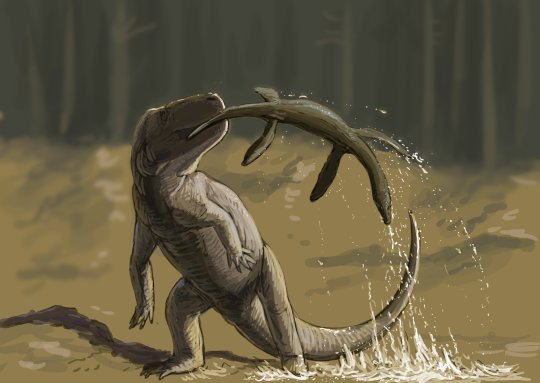
Colossosuchus
Fast forward to the Late Triassic, the hayday of early Pseudosuchians, and we find our first phytosaur of the list. Colossosuchus techniensis ("colossal crocodile of the Indian Institute of Technology") was an enormous animal from India's Tiki Formation. This one is known from undisputably better material, perhaps some of the best on this list as we have an entire bone bed of these guys, possibly representing a mass death site. Size estimates of the large specimens generally range from 6 to 9 meters in length, also making it the largest animal of this list, with the authors favoring an estimated 8 meters for the largest individual. Of course this is all subject to change, as we don't know the precise proportions (the downside of a bone bed is that all the bones are kinda jumbled together and god knows what belongs to what). Artwork by Joschua Knüppe again, a female being courted by an overconfident and confused Volcanosuchus (told you so)
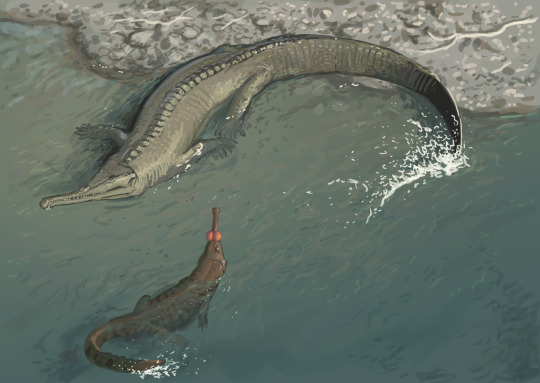
Kryphioparma
Ok I won't bother you with this one too much. Kryphioparma caerula ("blue mysterious shield") is an aetosaur from the Late Triassic Chinle Formation of Arizona. Now aetosaurs are cool of course, but the thing is that Kryphioparma is known from exclusively osteoderms, their large armour plates. While thats valid, its also not really exciting (as you could have guessed from the absolute lack of artwork). Best I can say is that it coexisted with a bunch of other aetosaurs, which surely would have been a sight to see back in the day.
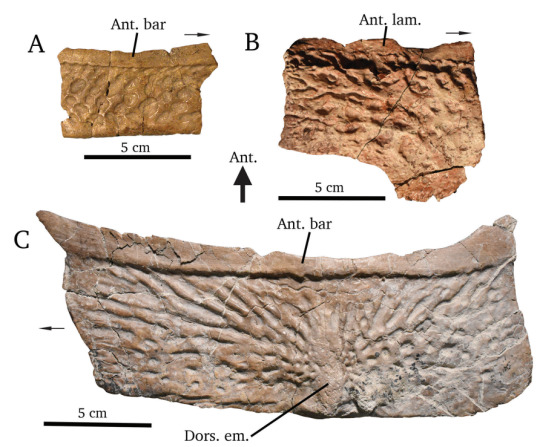
Venkatasuchus
Now Venkatasuchus armatum ("Venkata's armoured crocodile") is in a similar boat. This Indian aetosaur too is only known from osteoderms, tho at least a lot more of them that were found together, meaning we got a much better idea of its shape. There are some interesting implications it has on paleogeography and how different animal groups spread across Pangea, but that's probably beyond the scope of this post. There is at least some art of it tho, including one piece by Joschua featuring Jaklapallisaurus, an early sauropodomorph.
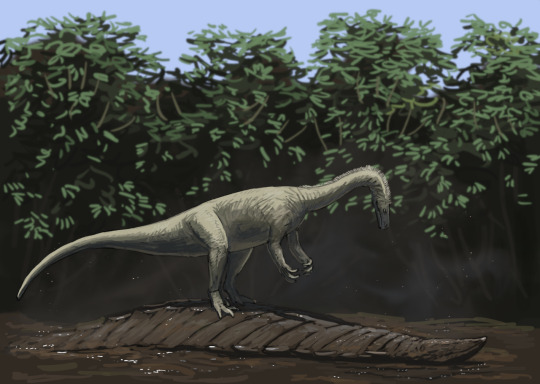
Mystriosuchus alleroq
Now we got our first new species of a preexisting genus. While I did my best to make posts on new genera, which typically went hand in hand with their respective wikipedia pages, species are a different matter since they'd require me to overhaul and research the whole genus. Which for Mystriosuchus would go all the way back to 1896.
Anyhow, Mystriosuchus alleroq ("jawbone spoon crocodile") is the newest in a long line of Mystriosuchus species and has been recovered from western Greenland of all places. Like Colossosuchus it is known from multiple individuals, at least four in fact, And like Venkatasuchus, it appears to have wideraning implications for the spread of archosaurs during the Triassic. Oh look its Josch's art again, neat.

Jupijkam
The final phytosaur and the final Triassic taxon of the year, Jupijkam paleofluvialis ("horned serpent of ancient rivers") was recovered from Nova Scotia Canada and represents one of the northernmost phytosaurs (alongside obviously our friend Mystriosuchus alleroq above). It is far less complete than the other phytosaurs I covered so far, but still nothing to scoff at. It's also one of the youngest known phytosaurs, possibly having lived during the last stage of the Triassic. There's no art but here's an image of its snout from the original paper.
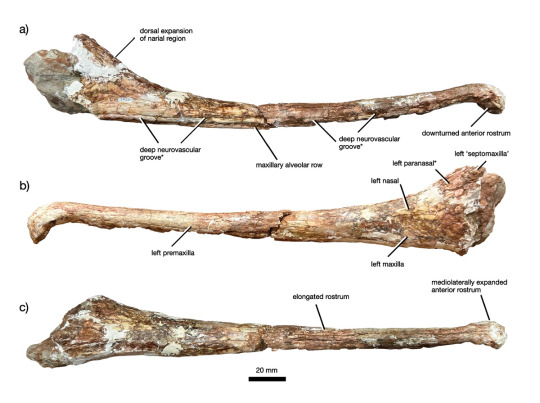
Turnersuchus
And with this we have reached the Jurassic and somewhat of a double feature. Ordering these via chronology makes this almost like storytelling. Turnersuchus hingleyae ("Hingley's and Turner's crocodile") is the oldest and basalmost named thalattosuchian, a group of crocodylomorphs that took to the seas. As such it shows a mosaic of features, already having begun to reduce its limbs, having a moderately long snout and still bearing osteoderms, which some of its descendents would come to lose. Turnersuchus dates to the Pliensbachian, a stage of the early Jurassic, tho the paper mentions how its not likely to hold its title as oldest member of its group for long as even older material has been discovered and is awaiting publication. Artwork by Júlia d’Oliveira and Joschua Knüppe


Torvoneustes jurensis
While Turnersuchus gives us a glimpse at what the earliest thalattosuchians were like, Torvoneustes jurensis ("savage swimmer of the Jura Mountains") represents them at one of their most derived. At 4 meters long, it must have been an impressive creature, entirely smooth and lacking osteoderms, highly reduced arms and a tail fluke to boot. There are some interesting features, as unlike other species of Torvoneustes, this one does not appear to have been as durophagous, instead appearing to be more of a generalist. It's the last Jurassic croc of the year and practically lived at the opposite end of this time period relative to our previous thalattosuchian, during the Kimmeridgian. Artwork by Sophie De Sousa Oliveira, not to be confused with Jùlia who drew Turnersuchus.

Comahuesuchus bonapartei
From marine to terrestrial, Comahuesuchus bonapartei is a member of the Notosuchia, land-dwelling cousins to the Neosuchia. This new species is known from the Cretaceous of Argentina and was described on the basis of a lower jaw, which differs from the previously described species of Comahuesuchus by the fact that the teeth are situated in individual sockets. Its jaws were short and wide, being described as U-shaped, giving it a somewhat pug-nosed appearance. In case you're wondering why I don't have the translation of the name thats because I can't access Bonaparte's first paper, so all I can say is that the new species is named after famed Argentinian paleontologist Jóse Fernando Bonaparte. Artwork by I mean you probably guessed it, its Josch again.

Aphaurosuchus kaiju
I have some mixed feelings on Aphaurosuchus kaiju ("powerless kaiju crocodile"), not just because I have to rewrite its genus wikipedia page that I am no longer happy with. No, Aphaurosuchus is a great genus in my opinion, given the complete nature of the holotype. But I do think that the species name of this second form is a bit of an exaggeration, seeing as it is to my knowledge not that exceptionally big. So why name it kaiju other than to sound cool? I also think it just kinda becoms funny when you consider the meaning of the genus name. Anyhow, it does look pretty mean, but thats to be expected from a baurusuchid. It lived during the Late Cretaceous in Brazil and the phylogenetic analysis that accompanied its description had some interesting implications that I'm curious to see tackled in the future. Other than that it's just another baurusuchid from a place crawling with baurusuchids, which tbh is pretty cool itself but doesn't really help make it stand out. Arwork by Paula Zeinner

Dentaneosuchus
It is the middle Eocene. France is entirely occupied by mammals. Well, not entirely... One indomitable reptile still holds out against the invaders. Yes, I am of course talking about Dentaneosuchus ("frightfull crocodile"), the titan of the Eocene, the terror of the jungle. Easily among the most exciting finds, this animal was an enormous sebecid previously thought to be a member of the genus Iberosuchus, but recent research not only shows its distinct but enormous. With a lower jaw around 90 cm long, it rivals even the famed Barinasuchus of Miocene South America. The total body lenght is of course a matter of debate given how little we know about sebecid proportions, with the paper lowballing it at 3 to 4 meters and I personally recovering something more akin to 5 meters. Regardless of the specifics, this would make it easily one of the top predators of its time, tho sadly this was not meant to last. It was among the last non-mammalian apex predators of Europe, before climate change and competition from mammals eventually drove them to extinction. Arwork by Joschua Knüppe and @mariolanzas
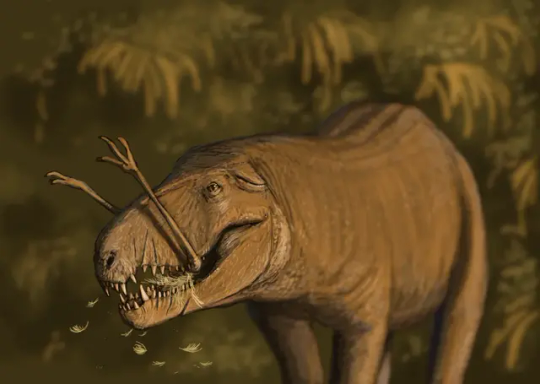

Baru iylwenpeny
Our last three entries were all members of the Notosuchia, the terrestrial crocodiles that existed from the Jurassic to the Miocene, so lets jump to the other major group of the time, the Neosuchians, specifically their most recent branch, the Crocodilians. Yes finally we are getting to crocs in the stricter sense.
Baru iylwenpeny ("divine crocodile thats good at hunting") is an animal we also knew for a while under the informal name Alcoota Baru based on where it was found. This year I spent a lot of time writing in the Mekosuchinae, Australasian crocodiles of the Cenozoic and just when I had finished the page for Baru, this guy got published. It's the largest, most robust and most recent member of the genus. Good at hunting is a good choice for the species name, as this animal was over 4 meters long with a head commonly likened to a cleaver and a hunting style speculated to consist of inflicting a lot of trauma on its prey with its massive teeth. I could gush about Baru for ages, but thats the important parts. It lived in central Australia during the Miocene only 8 million years ago. Artwork by the incredible @manusuchus

Antecrocodylus
Now for the last crocodilian described this year and one I remised to make a dedicated post for due to time constraints (I had a busy few months). Antecrocodylus chiangmuanensis ("before Crocodylus from Chiang Muan") is a close relative of the modern dwarf and true crocodiles from the Miocene of Thailand. It is only known from the back of the skull and an associated lower jaw, but it serves to highlight how little we know about the crocodiless of eastern Asia during the Miocene, which is a shame given that this region is crucial to deciphering where true crocodiles originated.

Alligator munensis
And our final taxon is Alligator munensis ("Mun river alligator"), which, obviously, is a member of the modern genus Alligator and thus most closely related to the still extant Chinese and American Alligator. Likely having been split from its Chinese relatives when the Tibetan plateau was lifted up, this species lived during the middle Pleistocene in Thailand and may have survived until the Holocene. It's head was short and robust and its teeth globular, which could indicate that it fed on hard-shelled prey like clams and snails. It was also small, likely not much bigger than 1.5 meters. Artwork by Joschua Knüppe


And that should be all of them, all new species and genera of Pseudosuchians described this past year. It's once again been fun to look back and I hope that you find them just as interesting as I do. Lets hope that 2024 will bring equally fascinating discoveries.
#alligator munensis#alligator#croc#crocodile#pseudosuchia#notosuchia#crocodilia#crocodylus#antecrocodylus#thalattosuchia#torvoneustes#paleontologoy#torvoneustes jurensis#turnersuchus#comahuesuchus#aphaurosuchus#aphaurosuchus kaiju#dentaneosuchus#jupijkam#colossosuchus#palaeoblr#prehistory#kryphioparma#venkatasuchus#mystriosuchus#scolotosuchus#baru#baru iylwenpeny#science
273 notes
·
View notes
Text
Capping demand from the top fifth, even at a fairly high level, cut greenhouse gas pollution from energy consumption by 9.7%, while raising demand from people in the bottom fifth who also live in poverty to a fairly low level increases emissions by just 1.4%. “We have to start tackling luxury energy use to stay within an equitable carbon budget for the globe,” said Milena Buchs, a professor of sustainable welfare at the University of Leeds and the lead author of the study, published on Monday in the journal Nature Energy, “but also to actually have the energy resources to enable people in fuel poverty to slightly increase their energy use and meet their needs.”
[...]
“The study confirms that energy demand reductions can contribute significantly to climate change mitigation, even as poorer households are lifted out of energy poverty,” said Felix Creutzig, an IPCC author and professor of sustainability economics at the Technical University of Berlin, who was not involved in the study. “High-income, high-education households have more scope and also more capacity in reducing their greenhouse gas emissions – and also carry more responsibility.”
[...]
Studies have shown the global rich – which includes middle-class people in rich countries – play a disproportionate role in heating the planet. In 2015, the top 1% of earners emitted twice as much carbon dioxide as the bottom 50%, according to estimates from the Stockholm Environment Institute and Oxfam. Rich people have more agency to cut their emissions and those of others. A commentary in Nature Energy argued in 2021 that this covered not just how they shop, which the authors stressed was a powerful lever, but also how they act as citizens, investors, role models and workers.
525 notes
·
View notes
Text
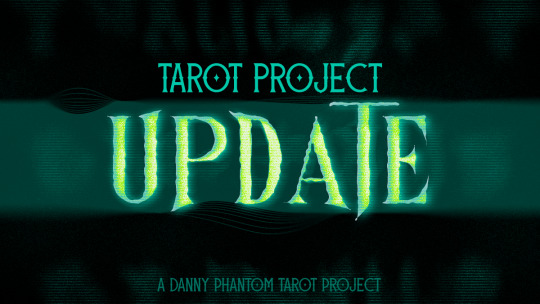
Hello friends. This is mod Jay coming at you barely alive with another update that includes an unfortunate delay. This should be the last one, and if it’s not, I’ll implode like a dying star in a major explosion that takes out everything around me and turns me into a blackhole that sucks in the debris and anything else that crosses my path. We’ve been working with this printing company and I am choosing to believe that they are trying their best but they lack communication and efficiency. We’ve told you a bit about what’s going on, the file transfer and formatting issues along with some mod health issues causing some delays but please believe me when I say we are doing our absolute best. Honestly, starting this project was kinda on a whim and most of the Mods have not moderated for a project of this scope, size or style, before. We did not know what we were signing up for. The printing company usually takes a few days to reply to the emails I send them and oftentimes their replies are vague and don’t actually answer the question or solve the problem I was contacting them about. They advertise a 14 day turn around, but that was misleading as it’s 14 days after FINAL approval, not initial approval.
What their provided timeline includes ✅ :
- time in the manufacturing process after final proof approval and before shipping
What their timeline doesn’t include ❌ :
- file transfer
- them coming back with feedback on the files
- adjustments we had to make to the files to fit their guidelines
- file transfer again
- file approval on their end to make the proofs
- our team approving the proof
- test pack manufacturing
- test pack shipping
- approval of final proofs once test pack received
- shipping of bulk order to me
- all the weekends/non work days that occur
- the time it takes for them to respond to emails when our team provides the necessary changes
Now we finally have a test deck on the way (that should arrive Wednesday according to the tracking information provided to me) and I’ll make another post when it arrives with some pictures. I’m out of town right now but I have a friend who will be picking up the package for me and taking some pictures so we can share the pictures with you as soon as possible.
Unfortunately it’s another 14 BUSINESS days until I get the bulk order SHIPPED to me, an estimation of about a week delivery time from there (based on how long shipping took from the printing company to me for the test pack BUT IT MAY BE LONGER AS THIS IS GOING TO BE A MUCH LARGER PACKAGE) and once that finally arrives I can ship them out to you guys.
If I could go back in time I probably would tell us to use a different printing company but unfortunately it’s too late to go with someone else. In the end we’ll wind up with a great product in my opinion but it’s been hard time getting there. I’m frustrated, and I’m sure many of you are as well. I get it, but they ARE coming.
Updated timeline: I plan to have everything shipped out by the end of July (Assuming the most recent information I got from the printers is accurate). I know that's like 8 weeks later than was originally communicated to ya’ll and I can’t express enough how sorry I am about all of these delays. It’s shit. It’s all a big flaming pile of shit. And I’m tired. So so tired. I see the light though! Now, is it the light at the end of the tunnel? Or is it heaven’s gate or hell’s fire? I don’t know. But we’re moving towards it together, hand in trembling, clenched, sweaty hand.
Thank you for your patience at this time and once again I am so sorry for all of these delays we’ve been facing. Another update will be posted on the tumblr and discord when the decks are shipped out!
Phazer loves you!!
#danny phantom#phantom's fate and fortune#tarot project#phandom#fandom collab#tarot cards#phazer announcement#updates
19 notes
·
View notes
Text
Major June 26th Political Update!
So, Paxton vs Free Speech Coalition and Birthright Citizenship + National Injunction cases will be settled most certainly tomorrow.
Keep an eye and ear out.
------
Now onto the Spending Bill news!
Here is a combined summary of all the updates from the Politico articles I checked:
The Republican-led "megabill" (also referred to as the "One Big Beautiful Bill") is facing numerous challenges and undergoing significant revisions due to rulings by Senate Parliamentarian Elizabeth MacDonough and internal disagreements within the GOP. Republicans are pushing to pass this comprehensive domestic policy bill—which includes tax, defense, energy, immigration, and health care provisions—before a self-imposed July 4 deadline, using the budget reconciliation process to bypass a Democratic filibuster.
Key Challenges and Parliamentarian Rulings:
Medicaid Provisions: The parliamentarian has dealt a major blow to the GOP's health care plans by ruling that several key Medicaid provisions cannot pass with a simple majority. This includes a plan to reduce Medicaid costs by cracking down on state provider taxes, which was expected to generate substantial savings, and proposals to exclude undocumented residents from Medicaid. These rulings have created an estimated $250 billion budgetary shortfall for Republicans.
Civil Service and Pension Reform: Initial proposals to restructure the federal workforce, such as giving federal employees an "at-will" designation and billing unions for official activities, were ruled out of order by the parliamentarian. Republicans are now exploring changes to their pension reform plan, proposing to increase federal employees' retirement contributions to 15.6 percent (from 9.4 percent) to help fund the megabill, though members of Congress, their staff, and federal law enforcement would be exempt. Democrats and unions strongly oppose these changes.
CFPB Funding: Senate Banking Republicans are proposing to cap the Consumer Financial Protection Bureau's (CFPB) funding at 6.5 percent of the Federal Reserve's operating budget, a reduction from the current 12 percent. An initial attempt to eliminate CFPB funding entirely was deemed ineligible. This new proposal awaits parliamentarian approval.
AI Moratorium: The parliamentarian has requested Senator Ted Cruz rewrite a proposed 10-year moratorium on enforcing state artificial intelligence (AI) laws, clarifying its scope of funding. While the measure is tied to a new $500 million fund for AI infrastructure, concerns remain that it could implicitly affect the entire $42 billion broadband program. The AI moratorium has also created divisions within the Republican party.
"Revenge Tax": Treasury Secretary Scott Bessent has asked lawmakers to remove a projected $52 billion "revenge tax" from the megabill, stating it is no longer necessary due to a "new understanding" with other developed countries regarding a global tax agreement, where central taxes will not apply to U.S. companies.
Overruling Parliamentarian: Despite calls from some conservative Republicans to do so, Senate Majority Leader John Thune has stated that the Senate will not move to overrule Parliamentarian Elizabeth MacDonough, emphasizing the importance of preserving Senate norms.
Approved Provisions:
SNAP Plan: The parliamentarian has approved a modified version of the Republican plan to shift some costs of the Supplemental Nutrition Assistance Program (SNAP) onto states. This is a significant win for Republicans, as it allows them to maintain a crucial $41 billion spending cut for the bill.
Internal Republican Divisions & Negotiations:
Medicaid Moderates: The proposed reduction of provider taxes in Medicaid expansion states is facing a "Medicaid-fueled mutiny" from moderate senators like Susan Collins, who find the proposed $15 billion rural hospital stabilization fund "inadequate." Some are threatening to block floor debate without more clarity on Medicaid changes.
SALT Deduction: Blue-state Republicans have rejected a Treasury offer to raise the cap on the State and Local Tax (SALT) deduction to $40,000, calling it "unrealistic." This remains a key unresolved issue.
Public Land Sales: Five House Republicans have declared a "red line" against including public land sales in the megabill, threatening to vote against it. They view it as a "grave mistake" and a "poison pill." This provision also faces strong Senate opposition.
Leadership Meetings & Deadlines:
Senate Majority Leader John Thune met with President Donald Trump at the White House as Republicans work against their self-imposed July 4 deadline. There is skepticism among some in the Senate GOP about whether they can get the bill to the President by this deadline. An initial vote to begin debate on the bill is now not expected before Saturday.
Kansas Governor Laura Kelly (D) anticipates that Senator Jerry Moran (R-Kan.), despite his objections to certain bill provisions, will ultimately vote with his party due to pressure from the comprehensive nature of the megabill.
The combination of parliamentarian rulings, internal Republican dissent, and complex negotiations across various policy areas is making the passage of the "megabill" a challenging and fluid process.
------
It seems that the bill is still being worked on so contact your Senators on troublesome provisions, reminding them to invoke the Byrd Rule against troublesome provisions should a procedural vote come before a new text is released.
General Page to call on the bill:
Page to call against Section 203, the provision that targets courts by requiring an expensive bond be payed to sue the government:
Page on AI regulation Ban:
------
Oh and congrats to Zohran Mamdani!
#section203#spendingbill#big bloated bill#big beautiful bill#big bill#we will not go back#do not obey in advance#fuck elon musk#fuck elongated muskrat#fuck trump#legislation#courts#contempt#bill#5calls#us politics#legal#be vigilant#supremecourt#supreme court#birthright citizenship#injunctions#zohran mamdani
12 notes
·
View notes
Text
Uncovering Hidden Costs with a Construction Cost Estimating Service
Construction projects often face unexpected expenses that can disrupt budgets and timelines. These hidden costs may arise from overlooked details, unforeseen site conditions, or changes in project scope. Identifying and accounting for such costs early is crucial for effective financial management. A construction cost estimating service plays an essential role in uncovering hidden costs, enabling project teams to create realistic budgets and avoid costly surprises.
Common Sources of Hidden Costs
Hidden costs in construction can originate from various areas, including:
Site conditions that differ from initial surveys
Design changes or scope creep during construction
Delays caused by weather, permitting, or labor shortages
Price fluctuations in materials or labor
Unexpected regulatory compliance requirements
Coordination and communication breakdowns among contractors
These factors can inflate project costs if not anticipated and managed properly.
Challenges in Detecting Hidden Costs
Incomplete Initial Data
Insufficient site investigations or surveys lead to surprises
Lack of detailed design documentation
Inadequate Risk Assessment
Failure to identify project-specific risks early on
Underestimating the likelihood or impact of certain events
Poor Change Management
Untracked scope changes causing budget increases
Ineffective communication among stakeholders
Market Volatility
Sudden price increases for materials or labor
Supply chain disruptions affecting availability and cost
How a Construction Cost Estimating Service Helps
Cost estimators use comprehensive techniques to identify potential hidden costs, such as:
Thorough site and design reviews to detect overlooked factors
Risk analysis incorporating probability and impact assessments
Detailed allowance and contingency budgeting
Market research to anticipate price trends and supply risks
Structured change management and cost tracking processes
Techniques to Reveal Hidden Costs
Value Engineering: Examining design alternatives to reduce costs without compromising quality.
Scenario Modeling: Testing “what-if” situations to evaluate cost impacts of delays or design changes.
Historical Data Analysis: Using past project data to identify common hidden cost drivers.
Supplier and Subcontractor Input: Engaging experts to uncover overlooked expenses.
Benefits of Addressing Hidden Costs Early
More accurate and reliable budgets
Increased ability to secure financing with confidence
Reduced risk of project delays and disputes
Improved stakeholder trust through transparency
Better decision-making under changing conditions
Conclusion
Hidden costs are an inevitable challenge in construction, but they don’t have to derail projects. A construction cost estimating service provides the expertise and processes needed to uncover and quantify these costs early. This proactive approach helps project teams manage financial risks, maintain control over budgets, and achieve successful outcomes.
#hidden costs#construction estimating#risk management#contingency budgeting#site conditions#scope creep#cost overruns#change management#price fluctuations#supply chain risk#value engineering#scenario modeling#project delays#budgeting accuracy#financial risk#construction finance#cost tracking#subcontractor costs#market volatility#cost transparency#project disputes#construction budgeting#cost control#stakeholder trust#cost forecasting#project management#construction risks#cost analysis#budgeting challenges#construction projects
0 notes
Note
Hi! Im pretty sure someone already asked you this but I really want to know. When working on the comic, do you make a script for yourself or do you "just" work with the book as it is? I know that making a script adds another work to the already long list, but working with the book as it is seems really overwhelming (many words me not likey)
You know, I don't think I have answered this before! Not in-depth, at least. Here's how I do it.

This is my extra annotated copy of the book (my original copy remains untouched). Got it used and as-is from Powell's. I also have a digital copy of the book when I can't bring this copy with me. I underline certain things I don't want to forget in the artwork, and write little notes to myself here and there. It's not shown on this page, but sometimes I cross things out that I won't/can't adapt like worldbuilding info and smaller flashbacks. If dialogue needs to be changed for lettering purposes, I do that when I'm actually making pages, not at the annotating stage. In the digital copy, I highlight character and setting descriptions to keep track of. This process is actually how I made my second graphic novel, which was an adaptation of a short story I wrote.
The ratio up top is my book page to comic page estimate. Last chapter's ratio was 10:21, which is in the ballpark of 3:7. With it, I've figured out how long each chapter and section would be just for fun. I even have a rough estimate of how long the entire book would be in comic format with nothing cut from it (try plugging in the numbers yourself if you'd like a fun surprise).
If this were a real professional project, I would write out a script myself. I'd want to keep the whole book in mind instead of doing it chapter by chapter. Working directly from the book for how things are structured is just a way to make the comic faster. Even thinking about the last chapter, I have ideas already for what I would change to create a stronger comic adaptation. For now though, I just go off the individual chapter to create something more one-to-one. This project has always been a way to improve my art and comic skills before I graduate, so doing structural rewrites to the story, even though that would be necessary for an actual adaptation, is out of the scope of this personal project I do outside of my classes.
100 notes
·
View notes
Text
Because tuatara are very long lived - between 100 and 200 years by most estimates […] - the founding of Aotearoa/New Zealand as a modern nation and the unfolding of settler-wrought changes to its environment have transpired over the course of the lives of perhaps just two tuatara [...].
---
[T]he tuatara (Sphenodon punctatus) [...] [is] the sole surviving representative of an order of reptiles that pre-dates the dinosaurs. [...] [T]he tuatara is of immense global and local significance and its story is pre-eminently one of deep timescales, of life-in-place [...]. Epithets abound for the unique and ancient biodiversity found in Aotearoa/New Zealand. Prized as “Ghosts of Gondwana” (Gibbs 2008), or as denizens of “Moa’s Ark” (Bellamy et al. 1990) or “The Southern Ark” (Andrews 1986), the country’s faunal species invoke fascination and inspire strong language [...]. In rounded terms, it [has been] [...] just 250 years since James Cook made landfall; just 200 years since the founding of the handful of [...] settlements that instigated agricultural transformation of the land [...]. European newcomers [...] were disconcerted by the biota [...]: the country was seen to “lack” terrestrial mammals; many of its birds were flightless and/or songless; its bats crawled through leaf-litter; its penguins inhabited forests; its parrots were mountain-dwellers; its frogs laid eggs that hatched miniature frogs rather than tadpoles [...].
---
Despite having met a reassuringly temperate climate [mild, oceanic, comparable to western Europe], too, the newcomers nevertheless sought to make adjustments to that climate, and it was clear to them that profits beckoned. Surveying the towering lowland forests from the deck of HMS Endeavour in 1769, and perceiving scope for expansion of the fenland drainage schemes being undertaken at that time in England and across swathes of Europe, Joseph Banks [botanist on Cook's voyage] reported on “swamps which might doubtless Easily be drained” [...]. Almost a century later, in New Zealand or Zealandia, the Britain of the South, [...] Hursthouse offered a fuller explication of this ethos: The cultivation of a new country materially improves its climate. Damp and dripping forests, exhaling pestilent vapours from rank and rotten vegetation, fall before the axe [...]. Fen and march and swamp, the bittern’s dank domain, fertile only in miasma, are drained; and the plough converts them into wholesome plains of fruit, and grain, and grass. [...]
[The British administrators] duly set about felling the ancient forests of Aotearoa/New Zealand, draining the country’s swamps [...]. They also began importing and acclimatising a vast array of exotic (predominantly northern-world) species [sheep, cattle, rodents, weasels, cats, crops, English pasture grasses, etc.] [...]. [T]hey constructed the seemingly ordinary agronomic patchwork of Aotearoa/New Zealand's productive, workaday landscapes [...]. This is effected through and/or accompanied by drastic deforestation, alteration of the water table and the flow of waterways, displacement and decline of endemic species, re-organisation of predation chains and pollination sequences and so on [...]. Aotearoa/New Zealand was founded in and through climate crisis [...]. Climate crisis is not a disastrous event waiting to happen in the future in this part of the world; rather, it has been with us for two centuries already [...].
---
[T]he crest formed by the twinned themes of absence and exceptionalism [...] has shaped this creature's niche in the western imagination. As one of the very oldest species on earth, tuatara have come to be recognised [in Euro-American scientific schemas] [...] as an evolutionary and biodiversity treasure [...]. In 1867, [...] Gunther [...] pronounced that it was not a lizard at all [...] [and] placed the tuatara [...] in a new order, Rhynchocephalia, [...] igniting a frenzy of scientific interest worldwide. Specifically, the tuatara was seen to afford opportunities for "astonished witnessing" [...], for "the excitement of having the chance to see, to study, to observe a true saurian of Mesozoic times in the flesh, still living, but only on this tiny speck of the earth [...], while all its ancestors [...] died about one hundred and thirty-five million years ago" [...]. Tuatara have, however, long held special status as a taonga or treasured species in Māori epistemologies, featuring in a range of [...] stories where [...] [they] are described by different climates and archaeologies of knowledge [...] (see Waitangi Tribunal 2011, p. 134). [...]
While unconfirmed sightings in the Wellington district were reported in the nineteenth century, tuatara currently survive only in actively managed - that is, monitored and pest-controlled - areas on scattered offshore islands, as well as in mainland zoo and sanctuary populations. As this confinement suggests, tuatara are functionally “extinct” in almost all of their former wild ranges. [...] [Italicized text in the heading of this post originally situated here in Boswell's article.] [...] In the remaining areas of Aotearoa/New Zealand where this species does now live [...], tuatara may in some cases be the oldest living inhabitants. Yet [...] if the tuatara is a creature of long memory, this memory is at risk of elimination or erasure. [...] [T]uatara expose and complicate the [...] machineries of public memory [...] and attendant environmental ideologies and management paradigms [...].
---
All text above by: Anna Boswell. "Climates of Change: A Tuatara's-Eye View". Humanities, 2020, Volume 9, Issue 2, 38. Published 1 May 2020. This article belongs to the Special Issue Environmental Humanities Approaches to Climate Change. [Bold emphasis and some paragraph breaks/contractions added by me. Text within brackets added by me for clarity. The first paragraph/heading in this post, with text in italics, are also the words of Boswell from this same article. Presented here for commentary, teaching, criticism purposes.]
#i posted commentary about this article in 2020 right after it was first published but i did a sloppy job presenting and discussing it#some might be familiar with boswells 2015 article on longfin eels or her article the stoat free state on weasels in aotearoa#basically she writes on british imperial environmental imaginaries#how settlement tries to reshape a colonys landscape in idealized english image of domesticated home replacing native species with introduce#ecology#abolition#imperial#colonial#landscape#paleo#aotearoa#indigenous#multispecies#black methodologies#indigenous pedagogies
76 notes
·
View notes
Text
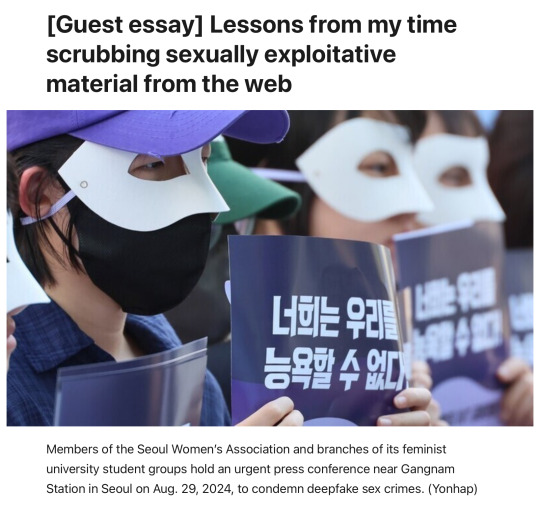
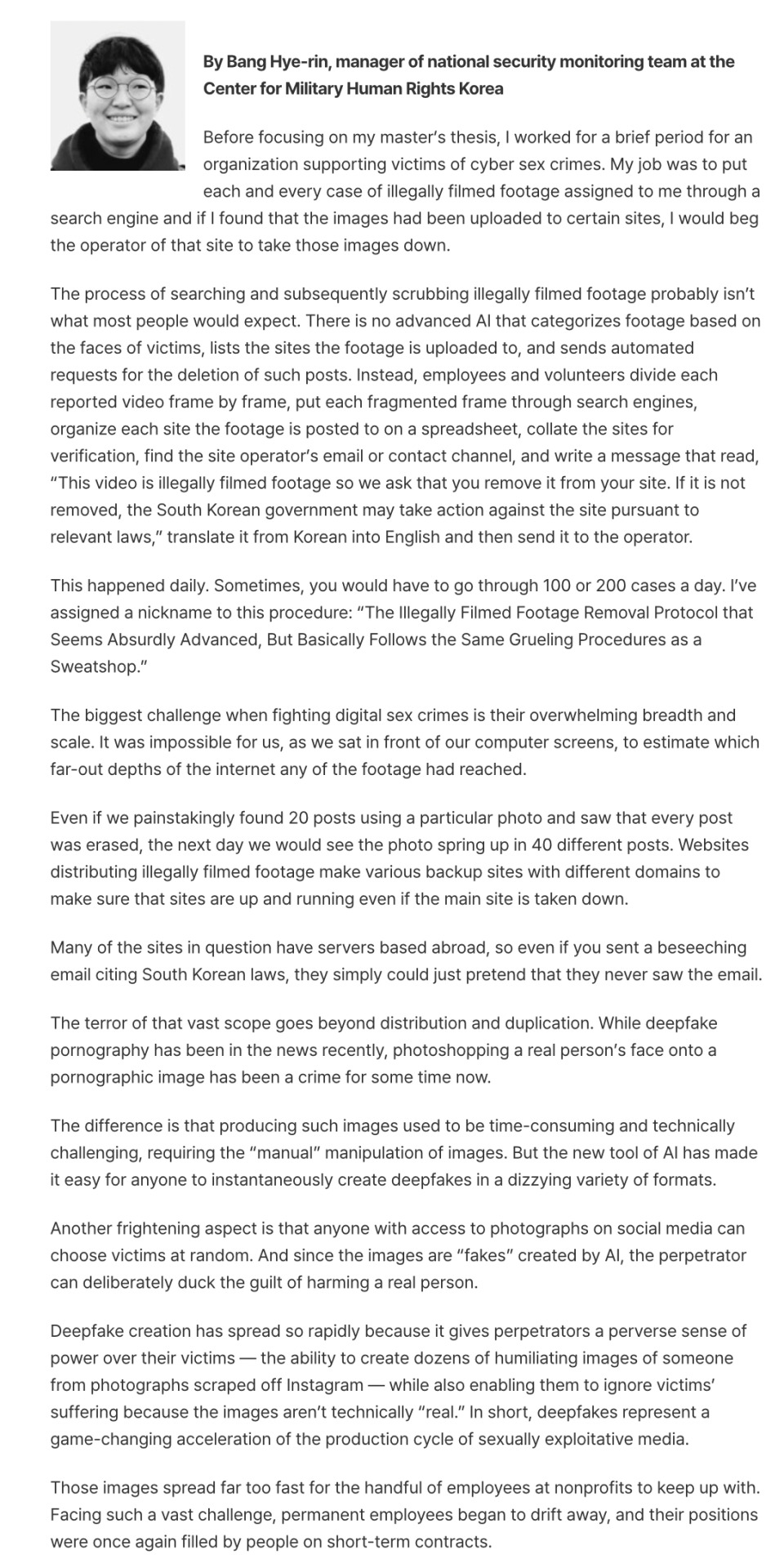

editorial from the english version of the Hankyoreh
archive link
plain text
Before focusing on my master’s thesis, I worked for a brief period for an organization supporting victims of cyber sex crimes. My job was to put each and every case of illegally filmed footage assigned to me through a search engine and if I found that the images had been uploaded to certain sites, I would beg the operator of that site to take those images down.
The process of searching and subsequently scrubbing illegally filmed footage probably isn’t what most people would expect. There is no advanced AI that categorizes footage based on the faces of victims, lists the sites the footage is uploaded to, and sends automated requests for the deletion of such posts. Instead, employees and volunteers divide each reported video frame by frame, put each fragmented frame through search engines, organize each site the footage is posted to on a spreadsheet, collate the sites for verification, find the site operator’s email or contact channel, and write a message that read, “This video is illegally filmed footage so we ask that you remove it from your site. If it is not removed, the South Korean government may take action against the site pursuant to relevant laws,” translate it from Korean into English and then send it to the operator.
This happened daily. Sometimes, you would have to go through 100 or 200 cases a day. I’ve assigned a nickname to this procedure: “The Illegally Filmed Footage Removal Protocol that Seems Absurdly Advanced, But Basically Follows the Same Grueling Procedures as a Sweatshop.”
The biggest challenge when fighting digital sex crimes is their overwhelming breadth and scale. It was impossible for us, as we sat in front of our computer screens, to estimate which far-out depths of the internet any of the footage had reached.
Even if we painstakingly found 20 posts using a particular photo and saw that every post was erased, the next day we would see the photo spring up in 40 different posts. Websites distributing illegally filmed footage make various backup sites with different domains to make sure that sites are up and running even if the main site is taken down.
Many of the sites in question have servers based abroad, so even if you sent a beseeching email citing South Korean laws, they simply could just pretend that they never saw the email.
The terror of that vast scope goes beyond distribution and duplication. While deepfake pornography has been in the news recently, photoshopping a real person’s face onto a pornographic image has been a crime for some time now.
The difference is that producing such images used to be time-consuming and technically challenging, requiring the “manual” manipulation of images. But the new tool of AI has made it easy for anyone to instantaneously create deepfakes in a dizzying variety of formats.
Another frightening aspect is that anyone with access to photographs on social media can choose victims at random. And since the images are “fakes” created by AI, the perpetrator can deliberately duck the guilt of harming a real person.
Deepfake creation has spread so rapidly because it gives perpetrators a perverse sense of power over their victims — the ability to create dozens of humiliating images of someone from photographs scraped off Instagram — while also enabling them to ignore victims’ suffering because the images aren’t technically “real.” In short, deepfakes represent a game-changing acceleration of the production cycle of sexually exploitative media.
Those images spread far too fast for the handful of employees at nonprofits to keep up with. Facing such a vast challenge, permanent employees began to drift away, and their positions were once again filled by people on short-term contracts.
Lee Jun-seok, a lawmaker with the Reform Party, said during a meeting of the National Assembly’s Science, ICT, Broadcasting and Communications Committee that the 220,000 members of a deepfake channel on Telegram was an “overblown threat” and estimated that, given the percentage of Korean users on Telegram, only about 726 of the channel members are actually Koreans.
But what does it matter whether there are 220,000 Koreans on the channel or just 726?
Let’s suppose there aren’t even 726, but just 10 people in the group — they could still produce 220,000 deepfakes if they set their mind to it. Those images would then be copied and circulated beyond their point of origin and around the world, perhaps remaining permanently in some dark corners of the Internet without ever being deleted.
That’s the nature of sex crimes in the digital age.
So assuming that the criminal potential of this technology remains the same regardless of whether the channel has 220,000 members, 726 members or even just 10, I can’t help wondering what Lee thinks would be an acceptable number of deepfake purveyors that would not constitute an “overblown threat.”
38 notes
·
View notes
Text
Judd Legum at Popular Information:
An internal Social Security Administration (SSA) memo, sent on March 13 and obtained by Popular Information, details proposed changes to the claims process that would debilitate the agency, cause significant processing delays, and prevent many Americans from applying for or receiving benefits. The memo, authored by Acting Deputy SSA Commissioner Doris Diaz, purports to be motivated by a desire to mitigate "fraud risks." Elon Musk has pushed several false claims about the nature and scope of Social Security fraud. In a recent interview on Fox Business, Musk suggested that 10% of federal expenditures were related to Social Security fraud. This is false. Social Security fraud does exist, but "improper" Social Security payments amounts to about $9 billion annually — less than 1% of total Social Security benefits paid and 0.1% of the federal budget. Most improper payments are not criminal fraud but the result of beneficiaries or the SSA failing to update records. The biggest change contemplated by Diaz's memo is to require "internet identity proofing" for "benefit claims… made over the phone." When an SSA customer is "unable to utilize the internet ID proofing, customers will be required to visit a field office to provide in-person identity documentation." Currently customers can make claims and verify their identity without using the internet or visiting a SSA office. Fraud is extremely rare because there are many safeguards in place. After initiating a call, customers must provide their social security number, date of birth, parents' names, mother's maiden name, and date of birth. After the initial teleapplication is completed, the information provided is checked against tax returns, pay stubs, bank statements, and medical information, depending on the nature of the claim. If there are any discrepancies, a customer may need to mail a copy of their birth certificate to the SSA. About 40% of all claims are currently processed over the phone. Because the SSA serves a large population that is either older or physically disabled, many cannot access the internet. Under the new system, this would force these populations to visit an office to have their claim processed. The Diaz memo estimates it would require 75,000 to 85,000 in-person visitors per week to SSA's offices to implement the policy. SSA offices do not currently have the resources to handle an influx of in-person appointments of this size. In 2023, the most recent data available, there were about 119,128 daily visits, on average, to SSA offices. Eight-five thousand more week visits would be a 14% increase. SSA offices no longer accept walk-ins and the wait time for an appointment, even before these changes, averaged over a month.
The memo anticipates creating a huge surge in demand for in-person appointments as the SSA slashes staff and closes offices. Acting SSA Commissioner Leland Dudek has announced that he will terminate 7,000 workers, about 12% of the workforce. Meanwhile, dozens of SSA offices are being shuttered. Some people need to travel more than 100 miles to get to the nearest location. As the SSA limits services that could be provided over the phone, it is ending in-person services at some offices, converting them to phone-only.
[...]
"DOGE's workaround"
On March 12, the day before the Diaz memo was sent, the Washington Post reported that the SSA was considering a proposal to "end telephone service for claims processing." That move, the paper reported, "would disrupt Social Security’s internal operations and threaten its ability to serve the public, current and former officials warned." In response to the Washington Post's article, the SSA issued a press release saying that "reports in the media that Social Security plans to eliminate telephone services are inaccurate." Rather, the press release said, phone service would only be eliminated in cases where beneficiaries need to change their banking information. The March 13 Diaz memo appears to be a way of implementing the original policy without technically ending telephone service for claims processing. Under the system described in the memo, customers can still use the phone to submit an application for a claim. The claim, however, would be considered "unverified" until an ID was verified through the internet or in person.
Popular Information reported on the Trump Regime’s plan to sabotage the Social Security Administration (SSA) under the purported guise of mitigating “fraud risks.”
16 notes
·
View notes